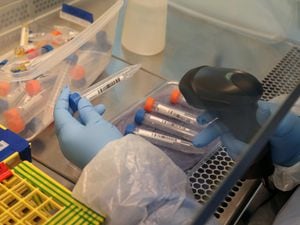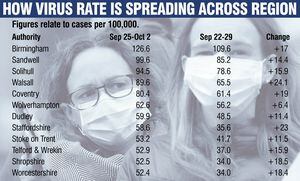Shropshire's Covid-19 rates rise after technical glitch in reporting cases
The Covid-19 rate has shot up across the region following a technical glitch in reporting cases.

Nearly 16,000 cases went unrecorded across the country last week as a result of a computer error, which led to a delay in efforts to trace contacts of people who tested positive for the virus.
Officials from Public Health England (PHE) said the glitch meant the rate of infection reported in parts of the country may have been lower than the true number.
A total of 15,841 additional cases with specimen dates between September 25 and October 2 have now been added onto the figures.

In Telford & Wrekin the infection rate was 37 per per 100,000 people in the seven days to September 29, but had risen to 52.9 in the seven days to October 2.
Meanwhile, Shropshire saw a rise from 34 to 52.5 and in Worcestershire the rate went from 34 to 52.4.
Birmingham's rate – the highest in the West Midlands – rose from 109.6 per 100,000 to 126.6.
More Covid-19 coverage:
It was initially believed that last week's data suggested infections may be rising more slowly than in previous weeks, while in some areas it appeared to be steadily falling.
South Shropshire MP Philip Dunne said he did not know whether the latest increase in the rate would be down to the glitch, but warned that the rise was concerning.
He said: "It's worrying that cases in Shropshire seem to be catching up with the national trend.
"Shropshire has been one of the areas in the West Midlands with the lowest case numbers through the summer and in September it remained so, but any increase is of concern.
Briefed
"I and other Shropshire MPs are being regularly briefed by the public health director from Shropshire Council and local NHS leaders on the preparations for an increase of cases leading to more expected hospital admissions.
"I've been assured that the health service is prepared to be able to cope with Covid and non-Covid admissions through a red and green site system to keep patients and staff safe."
Rachel Robinson, Shropshire’s director of public health, said: “Whilst the news about the issues with recording cases linked to the national IT system is concerning, it doesn’t alter the fact Shropshire is following the national trend when it comes to the rise in positive cases. The vast majority of Salopians are stepping up by following the measures designed to keep their friends and families safe, but we need everyone to pull together.
“Coronavirus is going to be with us for the foreseeable future, and we need everyone to play their part and help us cut the rate of infection here in Shropshire. We need a community effort - otherwise will be facing tougher measures and a local lockdown. We want to avoid this at all costs.
“If we continue to step up and follow all the measures, we can slow down the rates of infection.
“We all need to follow the guidelines when it comes to social distancing and limiting contact with people outside our household, not meeting in groups larger than six people outdoors, washing our hands and wearing face coverings.”
There were no further deaths of coronavirus patients reported in hospitals in Shropshire or Powys yesterday.
In the UK, the death toll rose by 19 to 42,369 and cases increased by 12,594 to 515,571.
Should we be alarmed at the rise or do we blame it on a data hiccup?
Ministers have left the Midlands “flying blind” in its attempts to handle the coronavirus pandemic, it was today claimed writes Peter Madeley, after the thousands of cases missed due to a computer error.
It means figures posted last week – which appeared to show a decline in Covid-19 rates in many areas – may have drastically underestimated the scale of the outbreak.
And crucially, the details were not passed on to contact tracers, resulting in a failure to track down people who had been exposed to the virus.
It has led to widespread confusion across the region, with health chiefs and politicians now considering whether the recent stabilisation of cases in some areas was based on dodgy information.
Work and Pensions Secretary Therese Coffey has admitted that the glitch may mean that many more people across the country could have been infected.
But it is not yet known if the upward movement is down purely to the previously missed figures or if they relate to a genuine rise in infections.
Consequences
Pat McFadden, the Shadow City Minister and MP for Wolverhampton South East, said the blunder had “undermined confidence in the degree to which the Government has a grip on this situation”.
“We need timely and accurate numbers to map the spread of the virus and to know whether or not these additional local lockdown measures that have been introduced are needed,” he added.
“Without accurate numbers we are flying blind.
“This matters because there are very real health and economic consequences to what is happening. With our own local area and around a quarter of the country nationwide living under some kind of local restrictions, we need to know exactly what the numbers are if we are to manage this second wave properly and help the economy get back on its feet.”
The rate of infection in parts of the West Midlands appeared to be slowing towards the end of last week, with some of the hardest hit areas including Birmingham, Sandwell and Wolverhampton all showing a decline in case numbers.
That trend appeared to reflect national predictions that we may be approaching the peak of the second wave and that there was hope local lockdown measures were having an effect.
However, the latest available figures show that rates have now increased across the board. It is not known whether the spike is down to the inclusion of the unreported cases.
In Sandwell the infection rate was 85.2 per 100,000 people in the seven days to last Tuesday, but had risen to 99.6 in the seven days to Friday.
Dudley saw a rise from 48.5 to 59.9, while in Walsall the rate rocketed from 65.5 to 89.6 over the period.
In Wolverhampton the rate went from 56.2 to 62.6, and across Staffordshire it rose from 35.6 to 58.6.
Birmingham’s rate – the highest in the West Midlands – rose from 109.6 per 100,000 to 126.6.
Solihull, which alongside Birmingham, Sandwell and Wolverhampton, is currently under extra lockdown restrictions, has seen the rate rise from 78.6 to 94.5.
Transferred
Public Health England (PHE) said the outstanding cases were transferred to NHS Test and Trace “immediately” after the issue was resolved and thanked contact tracers for their “additional efforts” over the weekend to clear the backlog quickly.
All cases were passed on to tracers by 1am on Saturday, meaning potential delays of more than a week in contacting thousands of people who were exposed to the virus and telling them to self-isolate.
PHE said every single person who was tested initially had received their test result as normal, with all those testing positive told to self-isolate.
The technical issue also means that daily totals reported on the Government’s coronavirus dashboard over the last week have been lower than the true number.
For example, 4,786 cases which were due to be reported on October 2 were not included in the daily total on the dashboard that day, when the figure was given as 6,968.
The Government’s dashboard said that, as of 9am on Sunday, there had been a further 22,961 lab-confirmed cases of coronavirus in the UK, taking the total number of cases in the UK to 502,978.
The confusion adds to criticism of the current test and trace system as well as local lockdowns that create piecemeal policies across the country.
Experts say there is scope for cautious optimism in that random surveys of the population appear to show the rate stabilising generally. But areas like the Midlands, North West and North East continue to be of concern.





